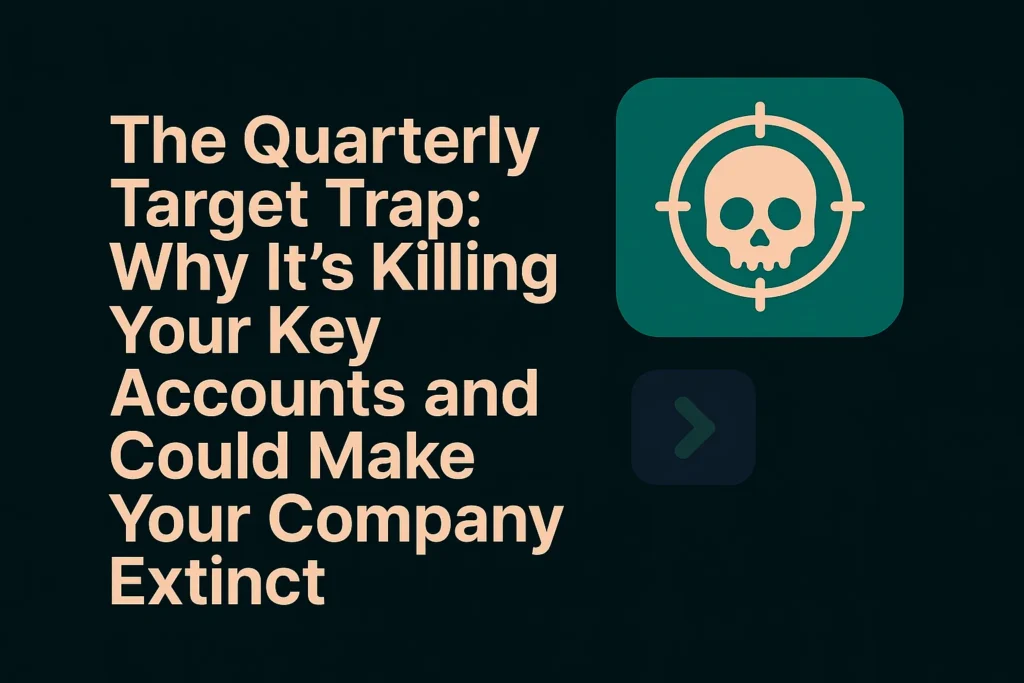The boardroom pressure is relentless. Every three months, another earnings call. Another set of analyst briefings. Another quarter where the stock price hangs in the balance of whether you beat, meet, or miss expectations by a few pennies per share. But this quarterly obsession isn’t limited to publicly traded companies. Venture capital and private equity-backed firms face their own version of the same pressure – quarterly LP reports, performance metrics updates, and the constant scrutiny of fund managers who themselves are measured on short-term returns.
Whether it’s a public company CEO facing Wall Street analysts or a VC-funded startup founder presenting quarterly metrics to their board, the drumbeat has become the heartbeat of modern corporate governance. But it’s slowly suffocating the very initiatives that could transform companies from good to legendary.
VC-funded companies operate under a unique form of quarterly pressure. While they don’t report to public shareholders, they face quarterly board meetings where metrics like Monthly Recurring Revenue (MRR), burn rate, and customer acquisition costs are dissected. Fund managers, themselves under pressure to deliver returns to Limited Partners within 7-10 year fund lifecycles, often push portfolio companies toward metrics that show immediate traction rather than long-term strategic positioning.
The irony is striking: venture capital, originally designed to fund long-term innovation, has increasingly succumbed to short-term thinking. Fund managers track Internal Rate of Return (IRR) and Total Value to Paid-In (TVPI) on quarterly basis, creating pressure for portfolio companies to optimize for metrics that look good in the next investor update rather than capabilities that drive sustainable competitive advantage.
This isn’t just about financial reporting, it’s about a fundamental misalignment between what creates sustainable value and what satisfies immediate stakeholders. The casualties of this quarterly obsession are numerous, but perhaps none more critical than key account management.
The Perils of Short-termism: Lessons from Intel & GE’s Downfall
Consider this sobering reality:
– 88% of Fortune 500 companies from 1955 have vanished.
– Half of the Fortune 500 companies that existed in 2000 are gone today. These weren’t failing businesses when they disappeared; many were profitable, growing, and seemingly unstoppable. Yet they’re gone.
– In the late 1970s, the average tenure of an organization on the S&P 500 index was approximately 35 years. Today, that average tenure is hovering closer to 20 years, with some projections forecasting a drop to as low as 12 years by 2028.
What happened with Intel?
Intel provides a perfect case study. In 2001, Intel was a tech titan, a cornerstone of the original Fortune 500 tech boom. Today, it’s fighting for survival. The company that once dominated semiconductors now trades at a fraction of its former glory, with a market cap that has plummeted as competitive pressures from TSMC, AMD, and others have eroded its position.
Intel’s decline wasn’t sudden. It was the result of years of decisions optimized for quarterly performance rather than long-term strategic positioning. The company missed the mobile revolution, fumbled the AI boom, and watched as more agile competitors captured the markets of the future.
General Electric under Jack Welch
GE under Jack Welch provides the perfect cautionary tale. Welch became a corporate icon by delivering 80 consecutive quarters of earnings growth, but this success ultimately masked a systematic short-termism that eventually led to the company’s destruction.
Research shows that GE’s earnings consistency was achieved through financial engineering rather than operational excellence. The company used GE Capital to smooth quarterly results, making acquisitions and disposals to hit earnings targets rather than building sustainable competitive advantages. When the financial crisis hit, this house of cards collapsed spectacularly.
The Welch era illustrates how quarterly obsession can create the illusion of success while hollowing out a company’s core capabilities. By 2020, GE’s market capitalization had fallen 55% from its peak, and the company that once exemplified American industrial might had become a cautionary tale about the dangers of short-term thinking.
I would highly recommend the book The Man Who Broke Capitalism by David Gelles, which compellingly explores how the short-term, quarterly earnings-focused leadership style epitomized by Jack Welch’s tenure at GE significantly contributed to the company’s eventual decline, offering critical insights into the dangers of prioritizing immediate financial performance over sustainable, long-term value creation.
How Quarterly Focus Hinders Key Account Management
Key account management is inherently a long-term play. It requires nurturing deep relationships, understanding evolving customer needs over the years, and investing upfront in tailored solutions.
The conflict between short-term urgency and long-term account development creates a dangerous gap: companies lose the ability to proactively identify growth opportunities within existing key accounts, leading to stagnation and increased vulnerability to competitors. Warren Buffett and Jamie Dimon captured this perfectly in their 2018 Wall Street Journal op-ed: “Quarterly earnings guidance often leads to an unhealthy focus on short-term profits at the expense of long-term strategy, growth, and sustainability”. They weren’t talking theory; they were describing the lived reality of thousands of corporate boardrooms where long-term initiatives get sacrificed on the altar of quarterly results.
Leading organizations that embrace mature KAM practices prioritize periodic, structured account reviews and multi-department collaboration, enabling them to maintain the rhythm of relationship management regardless of short-term sales cycles. These companies view KAM not as a tactical program but as a strategic capability essential to sustainable growth.
Yet under quarterly pressures, organizations:
– Focus disproportionately on new business acquisition or short-term pipeline metrics that boost immediate revenue.
– Conduct detailed monthly pipeline and deal reviews but rarely engage in systematic KAM QBR cycles.
– Treat key account initiatives as discretionary or tactical, vulnerable to cost-cutting during quarterly performance shortfalls.
The Effects of Neglecting Key Account Management
When KAM is sidelined, organizations lose their most profitable growth engine. Research shows:
– Revenue from key accounts typically grows 20-30% after mature KAM adoption.
– New business from existing key accounts has a 60-70% higher close likelihood than cold prospects.
– Customer acquisition costs are 5-7 times higher than retention costs, making KAM acceleration a cost-effective growth lever.
Ignoring KAM not only lowers current revenue potential but also weakens the organization’s strategic moat. Customers feel less valued and less understood, increasing churn risk and allowing agile competitors to capture market share.
How Leaders Can Think and Act Differently
The path forward requires fundamental changes in how companies approach strategic growth planning and stakeholder communication. Here’s what works:
– Eliminate Quarterly Guidance: Following Buffett and Dimon’s advice, companies should stop providing quarterly earnings per share guidance. Research shows that firms eliminating guidance don’t generate lower returns to shareholders, while reducing the pressure for myopic decision-making.
– Implement Long-Term KPIs: Measure what matters for long-term success. Key account management metrics like customer lifetime value, account penetration rates, relationship depth scores should carry equal weight with quarterly financial metrics in executive compensation.
– Invest in Patient Capital: Build financial reserves that enable long-term investments without quarterly pressure. Companies like Toyota and Berkshire Hathaway maintain substantial cash positions precisely to fund strategic initiatives when competitors cannot.
– Communicate Strategic Vision: Use quarterly reports to educate stakeholders about long-term value creation rather than managing short-term expectations. Share metrics on key account development, strategic capability building, and competitive positioning.
– Protect Strategic Initiatives: Ring-fence critical long-term investments like key account management programs from quarterly cost-cutting pressures. Treat these as strategic assets, not discretionary expenses
– Sales Leadership Integration: Sales leaders must embed KAM processes into routine sales cadence with monthly or quarterly key account business reviews, giving accounts the discipline and attention pipeline deals receive.
– Investment in KAM Capabilities: Organizations need to invest in dedicated KAM resources, account planning tools, and cross-functional collaboration platforms that enable deep customer insight and long-term joint value creation.
The Courage to Think Long-Term
Breaking free from the quarterly trap requires courage to disappoint analysts in the service of long-term value creation. It requires discipline to maintain strategic focus when quarterly pressures mount. Most importantly, it requires conviction that sustainable competitive advantages are built over years, not quarters.
The companies that survive and thrive over decades understand this fundamental truth: quarterly results are outcomes, not strategies. They’re the natural consequence of superior strategic positioning, deeper customer relationships, and stronger competitive capabilities. Key account management embodies this philosophy perfectly. It’s relationship-intensive, requires upfront investment, and delivers returns over time. It’s exactly the kind of strategic capability that quarterly-focused competitors will systematically underinvest in, creating opportunities for more patient players.
The question every CEO must answer is simple: Will you optimize for the next quarter’s analyst call, or will you build the capabilities that ensure your company appears on the Fortune 500 list twenty years from now? The choice between quarterly performance and long-term excellence isn’t really a choice at all, it’s a test of strategic courage.
In a world where half of today’s Fortune 500 companies will disappear over the next two decades, that courage might be the difference between joining the ranks of corporate legends and becoming another cautionary tale about the dangers of short-term thinking.
The quarterly trap is real, and it’s claiming victims every earnings season. Key account management and the long-term thinking it represents might just be the antidote modern corporations desperately need.

